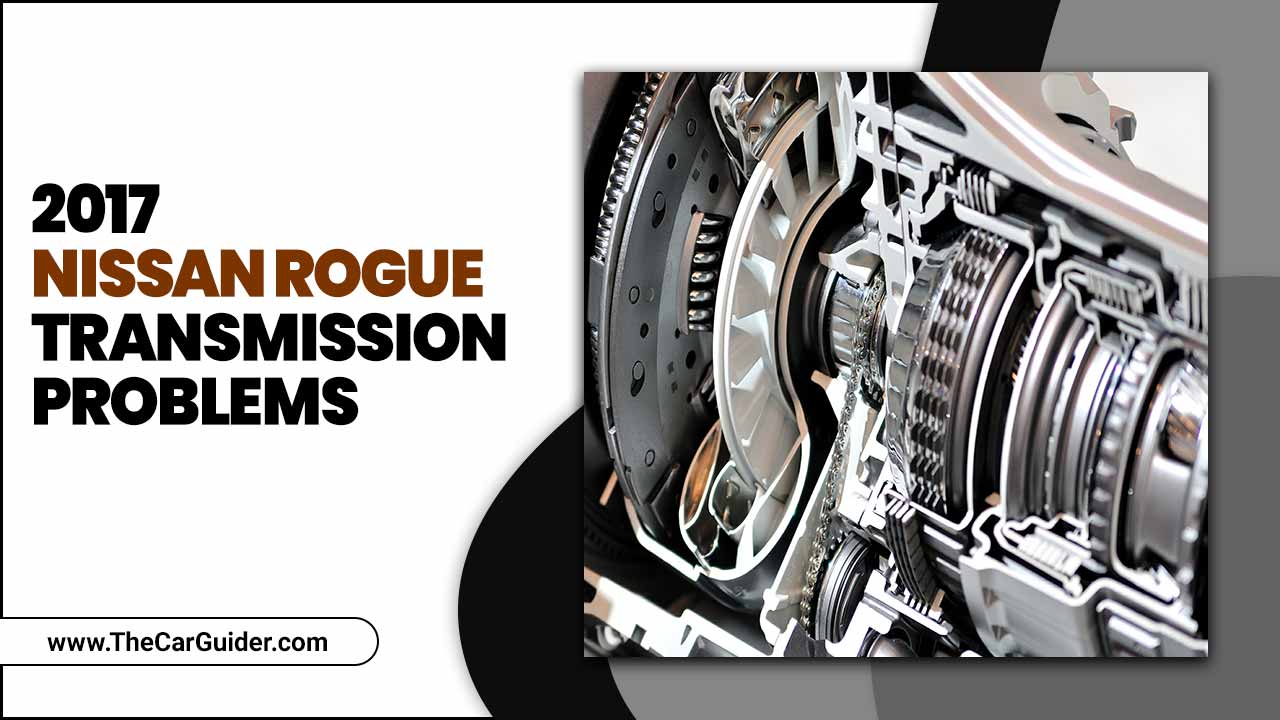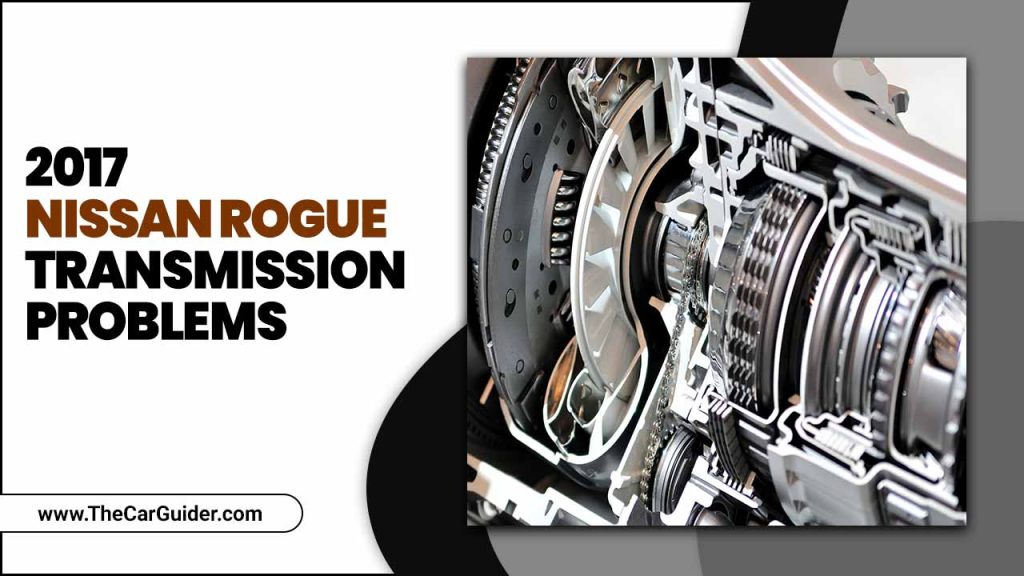The Nissan Rogue has been popular for those seeking a reliable and efficient crossover SUV. However, the 2017 model year has brought about a growing concern among owners and potential buyers – transmission problems.
Promptly addressing transmission problems is essential for a vehicle’s health and efficiency. Delaying fixes can cause severe damage, leading to costly repairs or transmission replacement. Immediate attention ensures smooth operation, prevents complications, and extends the vehicle’s lifespan.
Here, we will discuss how to recognize signs of transmission failure, identify common 2017 Nissan Rogue transmission problems, and explore potential solutions to fix them. We’ll also provide tips on how to prevent CVT transmission problems and determine if your vehicle has been recalled.

Recognizing Signs Of Transmission Failure
Recognizing signs of transmission failure in your 2017 Nissan Rogue is crucial to address the issue promptly and prevent further damage. Identifying problems early on, such as sensor malfunctions or erratic RPM, can prevent complete transmission failure and pricey repairs. Here are some common signs that may indicate transmission problems:
- Delayed engagement or shifting
- Slipping gears
- Unusual noises
- Leaking fluid
- Burning smell
What Is CVT Transmission
Before exploring the details of the Nissan Rogue transmission recall, it is important to provide some background information.
The Nissan Rogue is a well-known model in Nissan’s midsize crossover lineup, featuring the CVT (continuously variable transmission) gearbox manufactured by JATCO.
Nissan once hailed CVTs as a significant advancement in automatic transmissions. Unlike traditional transmissions, CVTs do not have physical gears or cogs. Instead, they utilize a chain or pulley system with a steel or rubber belt to adjust the transmission ratio seamlessly without the need for gear shifting.
This innovative design offers numerous benefits, such as smooth gear changes, potentially improved fuel efficiency, and a reduced risk of component failure. While CVTs may produce some noise, they are known for efficiently delivering power from the engine to the wheels by adjusting the pulleys’ positioning.
Identifying Solutions To 2017 Nissan Rogue Transmission Problems

Implementing effective solutions can significantly enhance the transmission performance of the 2017 Nissan Rogue. Ensuring a smoother and more efficient driving experience.
Addressing any transmission issues promptly is crucial, as it can prevent further damage and mitigate the potential risks of transmission failure.
By identifying and resolving these problems, owners can contribute to the longevity of their vehicles. Taking proactive measures such as regularly checking the fluid levels and inspecting the transmission for wear and tear. Replacing the filter and fluid when necessary is part of the best way to maintain the right amount of power in your SUV.
Symptoms Of Transmission Problems

The 2017 Nissan Rogue has been reported to experience several transmission problems, which can manifest through various symptoms. Being aware of these signs can help in diagnosing and addressing issues promptly. Key symptoms include:
- Slipping gears: The transmission might unexpectedly change gears, causing a noticeable loss of power or a sudden surge in engine speed.
- Delayed or rough shifting: Drivers may experience a delay when the vehicle shifts gears, or the transitions between gears may feel rough and jarring.
- Transmission fluid leaks: Puddles of red or brown fluid under the vehicle can indicate a transmission fluid leak, which can lead to serious transmission damage if not addressed.
- Warning lights on the dashboard: The appearance of warning lights, particularly the “Check Engine” light. Can signal underlying transmission problems that require immediate attention.
Causes Of Transmission Problems
The transmission problems in the 2017 Nissan Rogue can be attributed to several causes. Often requiring prompt attention to avoid severe damage. Key causes include:
- Overheating due to low transmission fluid: Insufficient fluid levels can lead to overheating, causing significant wear and damage to transmission components.
- Faulty transmission control module: A malfunctioning control module can result in improper gear shifting and other transmission issues, impacting overall vehicle performance.
- Worn-out clutch or torque converter: Over time, the clutch or torque converter may wear out, leading to slipping gears, rough shifting, and decreased transmission efficiency.
- Manufacturing defects or design flaws: Some transmission problems may stem from inherent defects or design flaws in the 2017 Nissan Rogue, which can compromise the transmission’s reliability and functionality.
Solutions To Transmission Problems

Addressing transmission problems in the 2017 Nissan Rogue requires a proactive approach and implementing several key solutions. Regular maintenance and frequent fluid checks are essential to ensure optimal transmission health.
Overheating Due to Low Transmission Fluid
Low transmission fluid can lead to overheating, a common transmission problem in vehicles like the Nissan Rogue, Nissan Pathfinder, or Nissan Altima. Addressing this issue promptly can prevent costly transmission repair or failure.
Here’s how to manage overheating in your Rogue CVT or other models with similar systems:
- Check Fluid Level: Use the dipstick to ensure the transmission fluid is at the correct level.
- Add Fluid: Add the manufacturer-recommended fluid, such as the Nissan Matic S, in small increments to avoid overfilling.
- Inspect for Leaks: Check for leaks around the manual transmission or CVT housing and repair as needed.
- Monitor Temperature: Watch the temperature gauge or warning lights for signs of overheating.
- Regular Maintenance: Follow the schedule outlined in your vehicle’s manual for transmission fluid changes and inspections.
Regular care and attention, along with staying informed via Nissan Rogue reviews, can help you maintain a reliable and efficient transmission system.
Faulty Transmission Control Module (TCM)
A malfunctioning Transmission Control Module (TCM) can lead to gear-shifting issues and affect overall vehicle performance. Addressing these problems quickly is vital to avoid extensive transmission repair or replacement. Here’s a quick guide:
- Run Diagnostic Scan: Use an OBD-II scanner to identify TCM-related error codes.
- Reset TCM: Disconnect the battery for a few minutes to reset the TCM and clear temporary faults.
- Inspect Wiring: Check for damaged or corroded wiring and connectors; repair or replace if needed.
- Replace TCM: If faulty, consult a Nissan dealership or qualified mechanic for replacement.
- Update Software: Ensure the TCM is running the latest Nissan-provided software version.
- Seek Professional Help: If issues persist, consult a mechanic for thorough diagnostics and solutions.
Timely action can prevent further complications and keep your vehicle running smoothly.
Worn-Out Clutch Or Torque Converter
Diagnosis:
Consult a qualified mechanic or take the vehicle to a Nissan dealership for a comprehensive diagnosis. They will assess the condition of the clutch or torque converter to determine if they are indeed worn out and in need of replacement.
Clutch Replacement:
If the clutch is identified as the culprit, it may need to be replaced. This involves removing the transmission from the vehicle and installing a new clutch assembly. The replacement should be performed by a skilled technician familiar with Nissan transmissions.
Torque Converter Replacement:
Similarly, if the torque converter is worn out, it must be replaced. This involves removing the transmission from the vehicle and installing a new torque converter assembly. Again, it’s essential to entrust this task to a qualified professional.
Driving Habits:
Avoid aggressive driving habits such as excessive speeding, rapid acceleration, and abrupt braking, as these can contribute to premature wear on transmission components.
Monitor Warning Signs:
Look for warning signs of clutch or torque converter problems, such as slipping gears, delayed or rough shifting, unusual noises, or transmission fluid leaks. Addressing these issues promptly can prevent further damage and costly repairs.
Preventative Measures
- Follow the manufacturer’s maintenance schedule
- Using high-quality transmission fluid
- Avoiding aggressive driving habits
- Monitoring warning signs and addressing issues promptly
Preventing transmission problems in the 2017 Nissan Rogue involves several proactive measures. Following the manufacturer’s maintenance schedule is crucial, as regular check-ups can identify and rectify issues before they escalate.
High-quality transmission fluid ensures optimal lubrication and cooling, reducing wear and tear. Avoiding aggressive driving habits, such as sudden acceleration and hard braking, can minimize stress on the transmission system.
Additionally, monitoring warning signs like slipping gears, delayed shifting, or dashboard warning lights and addressing these issues promptly can prevent extensive damage.
How Often Should Nissan CVT’s Transmission Fluid Be Changed?

Nissan CVT transmission fluid should be changed regularly to maintain optimal performance and longevity. Typically, replacing the CVT fluid every 30,000 to 60,000 miles is recommended, but this can vary based on driving conditions and vehicle usage.
It is essential to consult your vehicle’s manual and any relevant technical service bulletins (TSBs) issued by Nissan. For precise guidance, it’s advisable to visit an authorized Nissan dealership, where trained technicians can perform the service and ensure the use of high-quality CVT fluid.
Additionally, keeping an eye on recall summaries and warranty information from Nissan can provide important updates related to the CVT and other components, such as the coolant system.
The Transmission Overheating Issues In The 2017 Nissan Rogue
- Transmission Fluid Leaks: Decreased fluid levels cause overheating.
- Faulty Cooling System: Inadequate cooling from cooler or radiator issues.
- Heavy Towing or Hauling: Excessive load strain leads to overheating.
- Faulty Sensors: Malfunctioning sensors delay cooling response.
- Internal Transmission Problems: Increased friction from malfunctioning components.
While manual transmissions have historically been more resilient to overheating, the prevalence of CVTs in Nissan vehicles means that overheating concerns are more common.
Nissan North America has addressed some of these issues through recalls and warranty extensions. However, vigilance and regular maintenance are essential to mitigate overheating risks in the 2017 Nissan Rogue and other Nissan models with CVTs.
Conclusion
It is crucial to be aware of the signs of the 2017 Nissan Rogue transmission problems and take immediate action to address any problems. Regular maintenance, such as checking fluid levels, inspecting for wear and tear, and replacing filters and fluids, can help prevent transmission issues.
Additionally, it is important to stay informed about any recalls or updates regarding the transmission. While the 2017 Nissan Rogue has experienced some transmission problems, it is worth considering if the overall value and features of the vehicle align with your needs. Taking preventive measures and staying proactive can help ensure a smoother and more reliable driving experience with your Nissan Rogue.
Frequently Asked Questions
1. Are There Any Recalls For A 2017 Nissan Rogue?
Yes, there have been recalls for the 2017 Nissan Rogue, particularly related to transmission problems. Common Nissan Rogue problems include transmission issues, leading to recalls for transmission repair.
For the latest information on recalls affecting your Nissan vehicle, it’s advisable to check with a Nissan dealership or visit the National Highway Traffic Safety Administration website.
2. What Are The Transmission Repair Options For The 2017 Nissan Rogue?
For the 2017 Nissan Rogue with automatic transmission, transmission repair options include visiting authorized Nissan dealerships for transmission service. This may involve fluid changes or other maintenance procedures recommended by Nissan.
Owners can also access the MyNissan Owner Portal for information and assistance tailored to their specific Nissan models.
3. Does This Have A CVT?
Yes, many 2017 Nissan models, including the Rogue, feature a continuously variable transmission (CVT). CVTs offer smoother acceleration and better fuel efficiency. However, they can be prone to transmission issues.
If you notice any warning signs like the engine light or experience transmission problems, consult a Nissan dealer promptly. Additionally, check if your car insurance covers transmission-related issues.
4. What Are The Transmission Fluid Leak Causes In the 2017 Nissan Rogue?
Worn seals or gaskets, damaged transmission pans, and loose or faulty transmission fluid lines are common causes of transmission fluid leaks in the 2017 Nissan Rogue.
Neglecting maintenance schedules, driving in harsh conditions, or encountering road debris can exacerbate these issues. Addressing leaks promptly is essential to prevent damage to the transmission and maintain the reliability of the Nissan Rogue or Rogue Sport.
5. What Are The Transmission Fluid Capacity Details For The 2017 Nissan Rogue?
The transmission fluid capacity for the 2017 Nissan Rogue is approximately 5.1 quarts. However, the capacity of the Nissan Rogue Sport may differ.
Common problems associated with the 2017 Nissan Rogue include transmission issues like slipping gears, rough shifting, and other concerns like CVT reliability and occasional electrical glitches.
6.Do 2017 Nissan Rogues Have Transmission Problems?
Yes, some 2017 Nissan Rogue vehicles have reported transmission issues, particularly related to the Continuously Variable Transmission (CVT).
Common problems include delayed shifting, unusual noises, and transmission fluid leaks, which may lead to transmission failure if not addressed. Nissan Rogue owners should check for warning lights, review Technical Service Bulletins (TSBs)
Also, stay updated on recent posts about potential issues. Regular transmission service and transmission fluid changes are essential to maintaining the transmission’s health.
7.How Much Does It Cost To Replace A 2017 Nissan Rogue Transmission?
Replacing a 2017 Nissan Rogue CVT transmission typically costs between $3,000 and $5,000, depending on whether it’s a new or remanufactured unit and the labour rates at your Nissan dealer or local repair shop.
For Rogue owners experiencing transmission failure, exploring warranty coverage or assistance from Nissan may help reduce costs.
8.Can A Nissan Rogue CVT Transmission Be Rebuilt?
Yes, a Nissan Rogue CVT transmission can often be rebuilt, but it requires specialized knowledge and tools. Rebuilding a CVT transmission may cost less than replacement, typically around $2,000 to $4,000, depending on the extent of the damage and the availability of parts.
Nissan Rogue owners experiencing issues like delayed shifting or unusual noises should consult a Nissan dealer or a qualified repair shop to determine whether rebuilding is a viable option.







